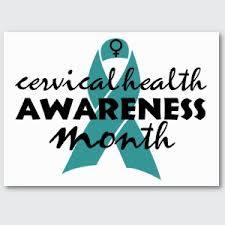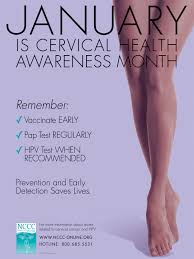Cervical Cancer Awareness Month



What is Cervical Health Awareness Month?
The United States Congress designated January as Cervical Health Awareness Month. During January, you may wish to highlight issues related to cervical cancer, HPV disease and the importance of early detection. Some of the issues you may wish to highlight are personal stories of women and family members/caregivers battling issues related to their persistent HPV/precancer and/or cervical cancer. You may wish to highlight recent advances and research in the prevention, detection and treatment of cervical cancer or HPV. You can highlight the success of your local/regional early detection cervical cancer screening and treatment programs and human-interest stories on the importance of early detection, education and the emotional issues related to battling cervical cancer and HPV.
Cervical Health Awareness Month 2012
Each January is recognized as Cervical Health Awareness Month. Each year in the U.S. approximately 12,000 women are diagnosed with cervical cancer, and more than 4,000 lives are lost as a result. This doesn’t take into account the many thousands of women who have cervical abnormalities and abnormal Pap tests for reasons other than cancer, but who still undergo expensive and inconvenient follow-up exams and treatments. Cervical Cancer Is Preventable
Cervical cancer is caused by specific types of the Human Papillomavirus (HPV), a common infection that almost everyone who is sexually active will have at some point. There are vaccines that block the types of HPV most often found with cervical diseases, and screening tests (such as Pap tests and HPV tests) that can identify women most at risk. We can prevent cervical cancer! - Vaccinate early (females and males ages 9-26 are eligible)
- Pap test regularly (beginning at age 21)
- HPV test when recommended
What Can You Do?
As someone who is interested in educating and advocating for increased knowledge of cervical cancer and HPV disease, you can do a lot. Motivation is the key, that, and the willingness to make contacts with local media. As part of a nation-wide education effort surrounding Cervical Health Awareness Month we are asking that state and local supporters of the NCCC mobilize to get the word out about cervical cancer and HPV. Specifically, we ask for three things:
- Distribute ASHA/NCCC's cervical cancer/HPV press release to state and local media;
- Enlist radio stations to announce Public Service Announcements (PSA) on cervical cancer and HPV; and
- Seek placement of the NCCC's "print" and Radio public service announcement in local newspapers and magazines.
Imagine the amount of education that could be accomplished if each state had a story and/or PSA placed in each of the three major media venues & radio, television and print.
To help you get started, we have developed this easy-to-follow guide on how to work with the media at the state and local level to spread the message of Cervical Health Awareness Month and the importance of early detection.Who Should You Contact?
To help spread the message as widely as possible, you should aim to contact the health or medical editor at each of your local newspapers and magazines, and the news directors or health reporters of each of your local television and radio stations. Because their time is often limited, be sure to be quick and concise in communicating your message.
It's important to keep track of all of your media contacts and to note their interest in reporting on cervical cancer/HPV. This will help to keep you organized, and will help you respond more efficiently and promptly to requests for information and interviews.How Can You Gain the Media's Interest?
State and local media are firmly committed to making the news they report relevant to their readers. In other words, they like to report what's happening in the neighborhoods they serve.
Strive to introduce elements of local interest to your story "pitch." There are a number of simple ways this can be achieved, just be creative.Some examples include:
- Make available local cervical cancer survivors for interviews. Local human interest "angles" are always popular with reporters, and their readers or viewers
- Talk about innovative research on cervical cancer/HPV that is going on at a local research university, or suggest local physicians who are willing to be interviewed.
- Organize a local event to raise awareness of, or money for, cervical cancer/HPV research and then invite media to attend. Be sure to send out announcements at least a week in advance to ensure the greatest amount of interest and attendance.
- Research local statistics on cervical cancer to provide as background to reporters. It can help to provide a local "tie-in" to a broader story about cervical cancer.
When Should You Get Started?
January is Cervical Health Awareness Month. That gives you plenty of time to get organized to work effectively through the media. The following is a rough timeline to help guide your activity:
- Develop your media contact list.
- Develop list of local experts and/or survivors who are willing to be interviewed.
- Begin to call magazine reporters who require a longer lead time to file their articles.
- Send copy for public service announcements to radio station managers. Follow-up with a phone call.
- Send press release to all print and broadcast reporters.
- Begin follow-up phone calls to all reporters, print and broadcast, to urge coverage of cervical cancer/HPV.

No comments:
Post a Comment